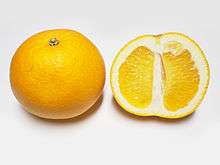Hassaku orange

Hassaku orange (Japanese: 八朔) is Japanese citrus hybrid similar to an orange in color but with the size of a grapefruit.
It originated in Hiroshima prefecture, but now Wakayama produces around 70% of the country's yield.
The Japanese eat the Hassaku as an orange, but it can be eaten with a grapefruit spoon to avoid the bitterness of the residual albedo. It is much more tart than an orange, but it does not lack sweetness entirely. When bitten into, juice bursts into the mouth from a slice of this fruit, considered very pleasant.[1]
In 2010, 68% of Japan's 35,919-ton hassaku harvest came from Wakayama prefecture, with the remainder mainly grown in Hiroshima, Ehime and Tokushima prefectures.
The fruit is mostly eaten raw, because, when cooked, it becomes more bitter. Currently, the idea of using ion-exchange resin is being suggested as a way to remove the bitterness, and so make it possible to commercialize the juice. Nutritionally, the fruit is a good source of vitamin C, folic acid, potassium and fiber.
References
- ↑ "Japanese Hassaku Fruit". nihonhacks.com.